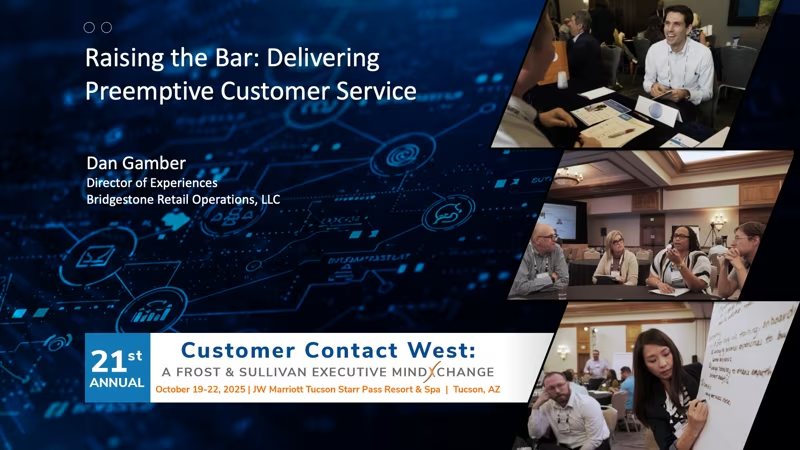Participants at the 21st Annual Customer Contact East: A Frost & Sullivan Executive MindXchange in Fort Lauderdale benefited from a wealth of industry insights and growth strategies shared in panel discussions, Executive Insight sessions, roundtables and more. Read on for key ideas shared by the event’s three distinct headliners: Darren Stavely, COO, Resolvion, Anindya Sundar Das, Senior Director, Head of Global Service Design, Uber, and Bobby Thompson, Director of Operations, Beazer Homes. You’re sure to learn from the best practices and practical “how-to’s” they shared – many can be implemented at your own organization today.

HEADLINER: Darren Stavely, Chief Operating Officer, Resolvion
Uncovering CX-Driven Growth Opportunities
Has your growth become stale? Business development stagnant? Is your market tapped out? Even if you own 99% market share (and let’s face it, we both know you don’t), there’s still an opportunity for 1% more. Instead of looking for new business, why not make your current customers true disciples or evangelists for your brand?
Operations and contact center leader Darren Stavely challenged established companies to look inward and focus on evolving what they already have. Rather than chasing every trend, he encouraged businesses to improve their existing customer experience strategies by being more intentional, innovative, and empathetic.
His message was clear: progress doesn’t always require reinvention, but it does demand reflection, personalization, and purpose.
KEY TAKEAWAY
Loyal customers are satisfied customers. Grow with what you’ve got.
ACTION ITEMS
Perfect these 5 things:
- Understand the customer’s pain points. Convince them that you care by listening. Listening to feedback leads to effective solutions. Implement post-interaction surveys, monitor online reviews and train frontline employees to ask for feedback.
- Personalize the experience. Make customers feel valued. Use data and insights to offer relevant and tailored experiences. Use CRM tools to track customer history and preferences, offer customized discounts or loyalty perks. Send personalized emails based on past interactions.
- Simplify the process. Remove friction. Make it simple and easy for customers to engage with your company. Streamline website navigation and checkout processes. Offer clear and accessible self-service options and reduce wait times.
- Give the customer control. Let them decide how to manage their experience by clearly communicating about self-service or phone options. Provide mobile apps with account management features. Offer chatbots, AI-assisted supports or telephone callback. Keep customers informed about order statuses.
- Create memorable moments. Delight customers by going above and beyond expectations. Offer unexpected perks such as discounts, gifts and upgrades. Train employees to go the extra mile and celebrate customer milestone moments.
FINAL THOUGHTS
Stavely left participants with a powerful reminder: improving customer experience isn’t just about flashy tools or trendy tactics — it’s about being intentional and consistent. He challenged businesses to reflect on the value of each customer and consider the long-term impact of even the smallest service improvements.
His call to action was clear: take what you’ve learned, apply it thoughtfully, and commit to continuously improving how you serve your customers. Because what you don’t fix today could become a big problem tomorrow.

HEADLINER: Anindya Sundar Das, Senior Director, Head of Global Service Design, Uber
Technology Enablement for Personalized and Predictive Services
In today’s rapidly evolving digital landscape, organizations can differentiate themselves by delivering personalized and predictive services. Leveraging cutting-edge technology can drive customer loyalty and competitive advantage — but only if executed thoughtfully. Successful tech-led transformations require strategic alignment, a clear understanding of cultural and regulatory nuances, and a relentless focus on value creation.
This session detailed how technology enables personalized and predictive customer services, differentiating the two concepts using Uber examples. It covered key tech enablers like granular segmentation, smart pricing, resource optimization, and proactive communication. The critical role of high-quality, timely, integrated, and machine-readable data was emphasized.
KEY DEFINITIONS
Personalized service: Tailored interactions based on individual preferences
- Example: Uber Black’s conversation preference feature that lets riders choose interaction levels
Predictive service: Anticipating needs proactively using data
- Example: Uber sending a timely notification suggesting a ride back to the hotel
KEY IDEAS AND STRATEGIES
The role of technology in tailored experiences includes:
- Granular customer segmentation
- Smarter win-win pricing
- Omni-channel support
- Proactive communication
- AI-driven sentiment analysis
ACTION ITEMS
- Identify high-value use cases: Define specific personalization/prediction opportunities with clear goals
- Build a robust data infrastructure: Invest in capturing, cleaning, integrating, and tagging data for availability, quality, timeliness, integrity, and machine readability
- Establish data governance: Implement a responsible governance framework addressing transparency, privacy, fairness, etc.
- Break down organizational silos: Foster cross-functional teams and align goals/KPIs
- Secure leadership buy-in and resources: Ensure consistent messaging and tangible support from leadership
- Train your teams: Educate relevant teams on data and personalization concepts
- Prioritize for ROI and long-term value: Focus resources on initiatives with the highest potential impact on customer retention and lifetime value
- Start small and iterate: Implement changes incrementally, celebrate successes, and learn from results
FINAL THOUGHTS
Personalization and predictive services are strategic imperatives. High-quality data is foundational. Decision-making driven by measurable returns and business impact that addresses cultural, regulatory and organizational alignment is key.

HEADLINER: Bobby Thompson, Director of Operations, Beazer Homes
Leadership Transitions: Growing and Developing Your Rising Stars
Investing in leadership development is a long-term strategy that benefits not only the individuals involved but also the entire organization and its stakeholders. Developing the next generation of leaders is crucial for adapting to the constantly evolving business landscape, driving innovation with fresh perspectives, building resilience, fostering a positive culture, meeting future needs, and ensuring continuity in leadership.
Bobby Thompson, an Army combat veteran with over 25 years of leadership experience, opened the session by asking participants to visualize a rising star they knew and could influence. He discussed how to grow rising stars to potentially surpass their leaders and emphasized the leader’s responsibility to invest in others.
Why invest in rising stars?
- They can help drive innovation and execute change effectively
- They can represent and protect the organizational culture (pipeline protection)
- They can generate positive ROI through energy, optimism, and advocacy
KEY STRATEGIES AND GUIDELINES
Identifying rising stars
- High potential + high performance
- Key observable behaviors: Learning agility (mental flexibility), leadership qualities, proactivity/adaptability, coachability (receptive to feedback, participates in 360s), emotional intelligence (EQ)
The ROI of investing early
- Builds loyalty and longevity in the individual
- Accelerates organizational growth through positive advocacy
- Prepares them for leadership roles (informal then formal)
- Prevents attrition by fostering a sense of belonging
Development framework (Explore -> Educate -> Advance)
- Explore: Build trust first by understanding the “whole human” (personal context, stressors). This is an essential foundation
- Educate: Identify skill gaps (potential assessments, peer/manager input). Collaboratively map a development path based on their vision and goals, using micro-steps
- Advance: Provide a “support channel” (senior mentors, peer coaching, genuine/regular feedback). Create psychological safety. Push boundaries appropriately
Leadership styles and empowerment
- Adaptability: Use EQ (ref: Daniel Goleman) to tailor leadership style to the individual and situation. Avoid one-size-fits-all
- Autonomy: Empower, encourage, and equip stars to act autonomously based on leader’s intent
- “Fail forward” coaching: When mistakes happen, coach on what could be done differently next time to build self-reliance, rather than criticizing
Data and measurement
- Leverage data on engagement, retention, promotion velocity, etc., to track the impact of development efforts
- Performance link: Strong company performance correlates with positive culture and employee development
Pitfalls to avoid
- Investing in someone who is not ready (leader sees potential, individual doesn’t)
- One-size-fits-all development plans/leadership style
- Inconsistent application of leadership style
- Stifling autonomy by criticizing failures instead of coaching
- Giving interim roles without real succession potential (destroys trust)
FINAL THOUGHTS
Developing rising stars is a crucial long-term leadership strategy that requires intentional investment beyond daily tasks. It starts with identifying the right individuals based on potential, performance, and key behaviors like coachability and learning agility. Building trust through genuine exploration of the whole person is foundational.
Patricia Jacoby, Senior Content Strategist at Frost & Sullivan, produces and frequently writes for the company’s monthly Customer Engagement and quarterly Innovation Newsletters. Throughout her tenure at Frost & Sullivan she has covered numerous industry sectors, including customer contact, marketing, innovation, and manufacturing, writing blogs, executive summaries, and white papers. She also supports and writes executive briefs for Frost & Sullivan’s Growth Innovation Leadership Council and Customer Engagement Leadership Council.



